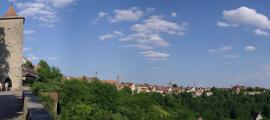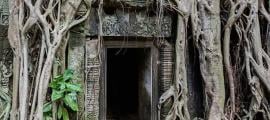☰ User Menu
16 JULY, 2018 - 11:14 BRYAN HILL
False Doors: The Gateways to the Egyptian Underworld
As the name would suggest, a false door is an imitation door usually found in mortuary temples and tombs across ancient Egypt. Facing west, these doors served as an imaginary passage between the world of the living and the world of the dead, and were believed to allow the Ka (an element of the soul) to pass through them. The deity or the deceased could interact with the world of the living either by passing through the door or by receiving offerings though it. The false door is one of the most common elements found within Egyptian tomb complexes, and is also one of the most important architectural features found in royal and non-royal tombs, beginning with Egypt's Old Kingdom.

Egyptian false door, c 2400 BC ( Sharron Mollerus / Flickr )
What is a False Door?
False doors were a common element within Egyptian temples of the New Kingdom dedicated to their ancient gods, as well as much earlier mortuary temples dedicated to the deceased and within the tombs themselves. Its typical form evolved out of the so-called “palace façade” external architecture of the Mastaba tombs of the elite in the Early Dynastic period (3100 - 2156 BC).
A typical false door has a long, narrow recessed panel which represented the actual doorway. Above this, a semi-cylindrical molding represented the reed mat generally used to close a real door. False doors were frequently made of a monolithic piece of fine limestone that were then often painted red with black spots. An example of this is found in the tomb of Sean khui ptah in the Teti cemetery at Saqqara. However, in the tomb of Hesire and in other rare instances, they might also be made of wood, or simply painted on the flat surface of a wall. Interestingly, though false doors were almost always completely fixed, in a few rare, early examples, they could have been furnished with moveable wooden panels.
The false door began as a small west-facing niche, which then developed to include a square or rectangular panel on which the owner was shown receiving the offerings. By adding door jambs below or beside the panel, the niche developed into a 'false door'. The Egyptians soon realized that the jambs and lintels of a stone door were excellent places to inscribe texts, and many examples show a doubling or trebling of the number of these elements. However, the concept of a door was not forgotten and numerous examples show carved bolts across the center of the 'opening'.

False doors evolved from the facades of Mastaba tombs, like this Mastaba Tomb of Perneb ( public domain )
Evolution of the False Door
The false door was first used in the Mastabas of the Third Dynasty of the Old Kingdom, and became nearly universal in tombs during the fourth through sixth dynasties. In the nearly one hundred and fifty years spanning the reigns of the sixth dynasty pharaohs Pepi I, Merenre, and Pepi II, the false door motif went through a sequential series of changes affecting the layout of the panels, allowing historians to date tombs based on which style was used. After the First Intermediate Period the popularity of the false doors diminished, being replaced by stelae as the primary surface for writing funerary inscriptions. The earlier three dimensional execution of these doors gave way to a simpler painted form during the New Kingdom.
- Top Ten Ancient Egyptian Discoveries of 2014
- Egyptian Hieroglyphs: The Language of the Gods
- 70 Million Mummified Animals in Egypt Reveal Dark Secret of Ancient Mummy Industry

Relief of Hesy-Ra (Hesire) from his Mastaba. Photo by James Edward Quibell, 2011. ( Wikimedia Commons )
A Gateway to the Afterlife
False doors were not copies of real doors, but a combination of an offering niche and a stela with hieroglyphic inscriptions. They are given the name because spiritual entities of the deceased were believed to have the ability to pass through the door. They were placed on the west wall of the main room in the chapel, known as an offering chamber. The narrow panel and molding were set inside a rectangular frame, often topped by a rectangular panel decorated with an image of the deceased sitting in front of an offering table. It was not uncommon to find false doors depicted on the sides of coffins or for a tomb to contain two false doors, one for the owner of the tomb and the other for his wife. There are also a few examples where each member of an extended family was given their own.

False door with depiction of tomb owner sitting in front of an offering table (rectangular section in top half of door). ( Wikimedia Commons )
Offerings for the Dead
Often a table was placed in front of the door on which offerings of food and drink were left for the deceased. The nourishment offered to the dead, could be real food on a slab or symbolic food carved into stela. The tables were usually made of stone and decorated with depictions of typical offerings (bread, beer, fowl, ox), with depressions to receive the gifts. The offering table took the form of the "hotep" hieroglyph (representing a loaf on a mat) and the formula was generally inscribed around him or her.
In general, false doors were highly decorated and marked with the names and titles of the grave's owner. The doorway could hold vertical line of hieroglyphs and often, lavish inscriptions on them could refer to countless offerings to the deceased. Along with these decorations, there could include a curse to those who would harm the deceased and a blessing to those who made offerings. For example, the false door in the tomb of Redi-ness at Giza (G 5032) has the following text inscribed which read:
Never did (I) do any evil thing against people. (As for) those who will do something against this, it shall be protected from them". (I) have constructed this my (tomb) with my own means. It is the god who will judge (my) case along with him who does anything against it.
People could also be represented on the lower parts of the decoration, facing inward, as if progressing towards the door. A representation of the deceased is frequently found on the doors and a few surviving false ones incorporate a life-size relief figure of the deceased stepping out of the niche. In some cases, there is also a statue of the owner in the central niche. For example, in the tomb of Nefer seshem ptah in the Teti cemetery at Saqqara, there was an engaged, standing statue in each of its outer jams and a bust statue in the central panel instead of the more typical offering table scene. Such raised relief statuary depicted the deceased emerging from the false door.
- Maat: The Ancient Egyptian Goddess of Truth, Justice and Morality
- Archaeological dig at ancient fortress site in Egypt reveals massive gate and graves of fallen warriors
- Two Ancient High Official Father and Son Tombs Opened at Pyramids Area in Egypt

False door with life-sized representation of the deceased stepping through it. Tomb of Mereruka ( Wikmedia Commons )
To the Ancient Egyptians, these doors were viewed as real gateways to the underworld and must have undoubtedly played an important role within their cult of the dead. Where present, false doors are some of the most beautiful elements within tomb complexes, and many survive, some in their original positions, while others have been removed and now exist in various museums throughout the world.
False Doors Outside of Egypt
Egypt is not the only place where such strange doors can be found. Other examples of similar structures are seen in South America. The mysterious “Gate of the Gods” door is located in the Hayu Marca mountain region of Peru and the natives there haves a legend that speaks of "a gateway to the lands of the Gods". In that legend, it was said that a time long ago, great heroes had gone to join their gods, and passed through the gate for a glorious new life of immortality. On rare occasions those men returned for a short time with their gods to "inspect all the lands in the kingdom".
In January, 2018, archaeologists discovered a false door in a Hellenisitic cemetery at the Al-Abd archaeological site in Alexandria. Dr. Ayman Ashmawy, head of the Ancient Egyptian Antiquities Sector, said that in this case, the false door had been placed there to deceive thieves and draw them away from the real door of the tomb.
Featured Image: False door at the tomb of Ka-Gmni. In Saqqara, outskirts of Cairo City. Photo by: Carlos Affonso. 2008. ( flickr.com)
References
"Architectural Elements." Reshafim. http://www.reshafim.org.il/ad/egypt/building/elements.htm
"British Museum - The 'false Door' in Ancient Egyptian Tombs." British Museum. http://www.britishmuseum.org/explore/highlights/article_index/fthe_false_door_in_ancient_egyp.aspx
"False Doors." Ancient Egyptian Society: False Doors. http://www.ancientegyptonline.co.uk/falsedoor.html
"Tour Egyp: Egypt: False Door." Tour Egypt. http://www.touregypt.net/featurestories/falsedoors.htm
Kinnaer, Jacques. "The Ancient Egypt Site." False Door. January 23, 2007. http://www.ancient-egypt.org/_v3d/index.html
"Architectural Elements." Used by Ancient Egyptian Builders. http://www.reshafim.org.il/ad/egypt/building/elements.htm
"False Door." EXECUTE LOST Solved. November 18, 2011. https://4815162342execute.wordpress.com/lost-themes/false-door/
"Gate of the Gods, Peru." Gate of the Gods, Peru. http://www.ancient-wisdom.co.uk/perugateofthegods.htm
RELATED ARTICLES ON ANCIENT-ORIGINS
22 JUNE, 2017 - 22:50 THEODOROS KARASAVVAS
New Revelations When 3,000-Year-Old Prosthetic Toe is Examined with Cutting Edge Technology
Egyptologists from the University of Basel have discovered details of production techniques and usage of one of the oldest prosthetic devices in history after re-examining it with the help of other...
- READ MOREABOUT NEW REVELATIONS WHEN 3,000-YEAR-OLD PROSTHETIC TOE IS EXAMINED WITH CUTTING EDGE TECHNOLOGY
13 MARCH, 2017 - 13:52 THEODOROS KARASAVVAS
Scientists Solve Mystery of Iron Strap and Buckle Unearthed in Medieval Cemetery
Archaeologists digging at Gloucester Cathedral, UK, have unearthed a strap for a medieval “false leg.” The metal pieces from the prosthesis band were discovered with a skeleton in the old lay...
12 APRIL, 2014 - 14:47 APRILHOLLOWAY
Top Ten Myths about Neanderthals
Neanderthals are generally classified by palaeontologists as the species Homo neanderthalensis, but some consider them to be a subspecies of Homo sapiens (Homo sapiens neanderthalensis). The first...
TOP NEW STORIES
As one of the twelve Olympians, Hephaestus was a major deity for the ancient Greeks. In Greek mythology, Hephaestus was primarily the god of fire and smiths, but he was also in charge of other crafts, including sculpting and carpentry.
MYTHS & LEGENDS
The Snallygaster is a mysterious unknown cryptid that is said to look like a dragon. The legend of the beast originated with German immigrants that settled in Frederick County in Central Maryland.
HUMAN ORIGINS
Most people who have the Rh blood type are Rh-positive. There are also instances, however, where people are Rh-Negative. Health problems may occur for the unborn child of a mother with Rh-Negative blood when the baby is Rh-Positive.
ANCIENT TECHNOLOGY
Wootz steel was amongst the finest in the world. It is the metal that was used to fashion weapons such as the famous Damascus blades of the Middle Ages. However, Wootz steel dates back much further...
ANCIENT PLACES
During Sir Charles Leonard Woolley’s excavation of Ur from 1922 to 1934, any burial without a tomb chamber was given the name ‘death pit’ (known also as ‘grave pits’). Arguably the most impressive...
OPINION
How old is the Tarot? This is a question that seems easy to answer today. As playing cards, we can confidently map the Tarot to the early 15th century. Mystery solved? Well, it’s not quite that simple.
OUR MISSION
At Ancient Origins, we believe that one of the most important fields of knowledge we can pursue as human beings is our beginnings. And while some people may seem content with the story as it stands, our view is that there exists countless mysteries, scientific anomalies and surprising artifacts that have yet to be discovered and explained.
The goal of Ancient Origins is to highlight recent archaeological discoveries, peer-reviewed academic research and evidence, as well as offering alternative viewpoints and explanations of science, archaeology, mythology, religion and history around the globe.
We’re the only Pop Archaeology site combining scientific research with out-of-the-box perspectives.
By bringing together top experts and authors, this archaeology website explores lost civilizations, examines sacred writings, tours ancient places, investigates ancient discoveries and questions mysterious happenings. Our open community is dedicated to digging into the origins of our species on planet earth, and question wherever the discoveries might take us. We seek to retell the story of our beginnings.
We use cookies on this site to enhance your user experience
Cookies are used for our site's proper functioning, insight into how the site is being used, and advertising. If you continue without changing your settings, you are consenting to the use of cookies on our site.





















No comments:
Post a Comment
Note: Only a member of this blog may post a comment.